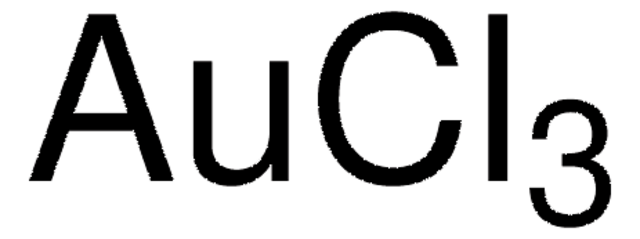334545
Potassium gold(III) chloride
98%
Synonym(s):
Potassium tetrachloroaurate(III), Gold potassium chloride
Sign Into View Organizational & Contract Pricing
All Photos(3)
About This Item
Linear Formula:
KAuCl4
CAS Number:
Molecular Weight:
377.88
EC Number:
MDL number:
UNSPSC Code:
12352302
PubChem Substance ID:
NACRES:
NA.23
Assay:
98%
form:
powder
solubility:
H2O: soluble
alcohol: soluble
ethanol: soluble
alcohol: soluble
ethanol: soluble
Recommended Products
Quality Level
Assay
98%
form
powder
solubility
H2O: soluble
alcohol: soluble
ethanol: soluble
SMILES string
[K+].Cl[Au-](Cl)(Cl)Cl
InChI
1S/Au.4ClH.K/h;4*1H;/q+3;;;;;+1/p-4
InChI key
JMONCQYBAMKVQQ-UHFFFAOYSA-J
Looking for similar products? Visit Product Comparison Guide
General description
The yellow crystals of potassium gold chloride are soluble in water. 1,2
Application
Key raw material for synthesis of new gold(III) dithiolate complexes for luminescence studies or possible uses as photosensitizers or photocatalysts.
Signal Word
Warning
Hazard Statements
Precautionary Statements
Hazard Classifications
Eye Irrit. 2 - Skin Irrit. 2 - STOT SE 3
Target Organs
Respiratory system
Storage Class Code
11 - Combustible Solids
WGK
WGK 3
Flash Point(F)
Not applicable
Flash Point(C)
Not applicable
Personal Protective Equipment
dust mask type N95 (US), Eyeshields, Gloves
Choose from one of the most recent versions:
Already Own This Product?
Find documentation for the products that you have recently purchased in the Document Library.
M. Adnan Mansour et al.
Inorganic chemistry, 37(18), 4625-4632 (2001-10-24)
Two Au(III) dithiolate complexes, [Au(dbbpy)(tdt)]PF(6) and Au(eta(2)-C,N-ppy)(tdt), (dbbpy = 4,4'-di-tert-butyl-2,2'-bipyridine; tdt = 3,4-toluenedithiolate; ppy = C-deprotonated 2-phenylpyridine), have been prepared and structurally characterized by X-ray crystallography. The complexes have low-energy absorption bands that exhibit mild solvatochromism (lambda(max) = 444 nm
Ja-an Annie Ho et al.
Analytical chemistry, 84(7), 3246-3253 (2012-03-01)
In this paper, we describe a simple one-pot method, employing l-3,4-dihydroxyphenylalanine (L-DOPA) as a reducing/capping reagent, for the synthesis of fluorescent gold nanoclusters (AuNCs). Within a short reaction time of 15 min (excluding the time required for purification), this strategy
Xiaokong Liu et al.
Langmuir : the ACS journal of surfaces and colloids, 28(38), 13720-13726 (2012-09-08)
In this report, we demonstrate a rapid and simple seeded growth method for synthesizing monodisperse, quasi-spherical, citrate-stabilized Au nanoparticles (Au NPs) via H(2)O(2) reduction of HAuCl(4). Au NPs with diameter ranging from 30 to 230 nm can be synthesized by
Sergey S Zalesskiy et al.
Journal of the American Chemical Society, 135(9), 3550-3559 (2013-01-02)
Soluble gold precatalysts, aimed for homogeneous catalysis, under certain conditions may form nanoparticles, which dramatically change the mechanism and initiate different chemistry. The present study addresses the question of designing gold catalysts, taking into account possible interconversions and contamination at
Xiaorong Zhang et al.
Nanotechnology, 22(35), 355603-355603 (2011-08-11)
In this paper, a pH-inductive protein-scaffold biosynthesis of shape-tunable crystalline gold nanoparticles at room temperature has been developed. By simple manipulation of the reaction solution's pH, anisotropic gold nanoparticles including spheres, triangles and cubes could be produced by incubating an
Our team of scientists has experience in all areas of research including Life Science, Material Science, Chemical Synthesis, Chromatography, Analytical and many others.
Contact Technical Service








